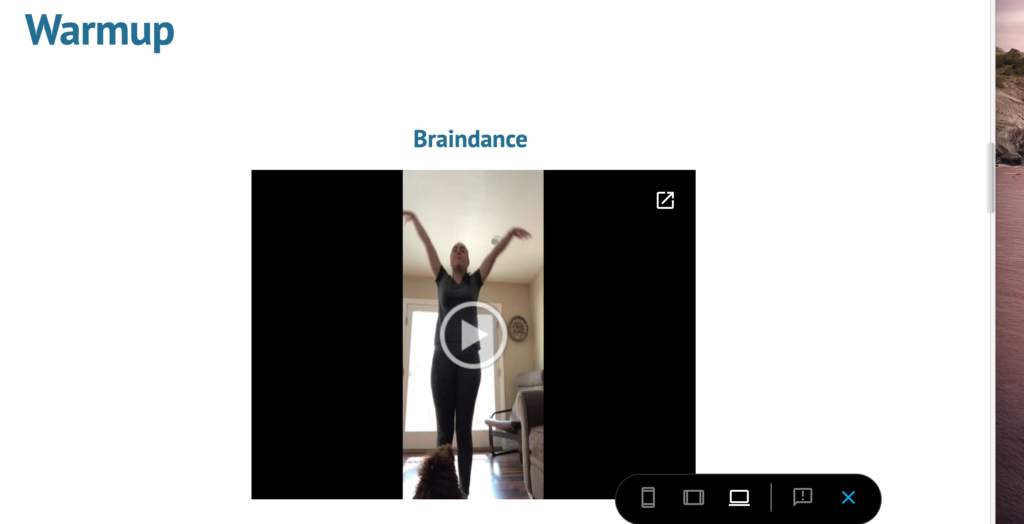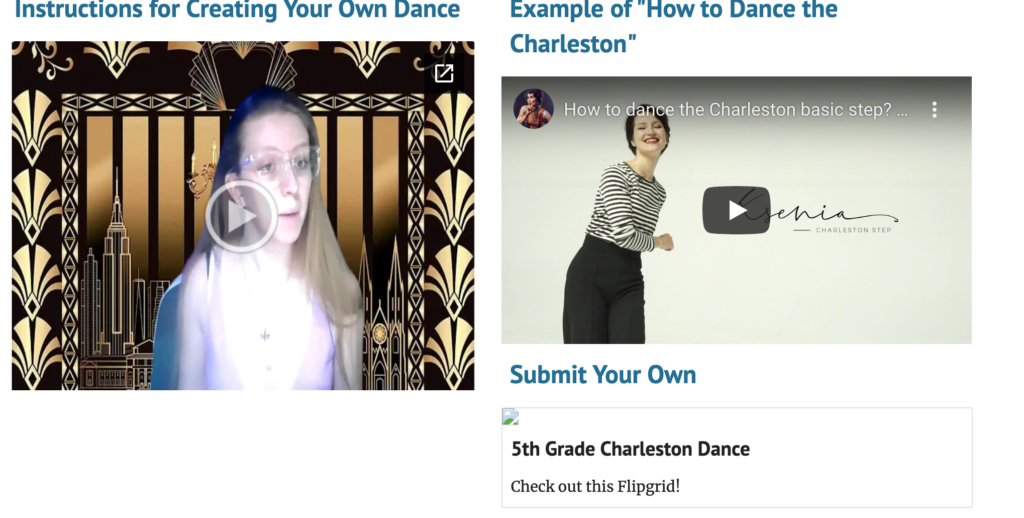Faculty Info
Name: Elizabeth (Bonnie) Lavin-Hughes
Academic Program: Performing Arts- Dance (PADA)
Average Number of students per section: 24
Featured Course:
- PA 210- Understanding Dance and Music in Elementary Education
Had you taught online prior to the rapid shift to virtual instruction in response to COVID-19?
No, not until Spring ’20 when CSUCI unexpectedly moved all courses online
What practice or technique have you implemented in your course?
I incorporated Flipgrid into my PA 210 curriculum. During my summer work with T.H.R.I.V.E., I was always on the lookout for teaching resources that resonated with my discipline, dance. Collaboration, social and emotional intelligence, creativity, and kinesthetic awareness, all play important roles in my pedagogy as a dance educator and when I encountered Flipgrid during the T.H.R.I.V.E. office hours, I can say I was excited! I saw huge potential for this app in my discipline.
I began to explore and implement Flipgrid into my curriculum right away, designing some low stakes activity assignments for the students that required them to film a braindance tutorial for their imaginary classrooms and favorite grade levels. I teach emerging educators how to consider integrating the elements of music and dance into their teaching practice. In part, I do this through various experiential activities and movement assignments that grow out of these activities.
My students are non-dancers, meaning the movement explorations can be discomforting at times, fun and enlightening, they admit, in their journal reflections, but weird, none the less, as also expressed in their reflections. Interestingly, Flipgrid seemed to support their breakthroughs from the discomforts of exploring movement when working with subject matter lessons. I began to notice that when they submitted their Flipgrid assignments they were smiling, there was more prosody in their voices and they were noticeably enjoying the process.
I decided to include this app as an option to investigate and possibly integrate into their final projects and the results have been encouraging and refreshing! Hopefully, I can excerpt images and clips from the projects to demonstrate the imagination and performative growth that my emerging educators accomplished with their integrated lesson designs using Flipgrid.
I also was grateful to learn about Padlet for online teaching. You will see that tool come up in one of the screen shots as well, the students incorporated it into their final projects as a means for reflection for their students.
I can speak to Flipgrid and Padlet as useful, user friendly online teaching tools that enhance student engagement! I am so grateful to have been turned onto such tools during thrive!
Why did you choose this approach?
I chose to incorporate the Flipgrid app into my curriculum planning to facilitate for my students a fun and accessible method for submitting their integrated lesson plan assignments that required them to include movement tutorials.
Describe any change in your own philosophy of teaching and learning due to virtual instruction?
I still pine deeply for SPACE that supports movement explorations, I still believe wholeheartedly that in person teaching is paramount for a rich and meaningful experience in my PA 210 course, and I continue to feel overwhelmed by this online environment as a somatic human forced to function inside a small box and desk chair. That said I can attest to learning so much that my head spins and I can say that in persevering and saying “YES” during thrive (a willingness to try new things and be open) I have grown as teacher and I have been able to maintain my core values in my teaching, community, creativity, and collaboration. Virtual instruction has taken me from HATE to hopefulness as I continue to breathe, ask that cameras be on and ask that everyone stretch their arms out like they are hugging a big redwood tree (a daily ritual) that assures us that we are willing to listen and support each other!
When courses resume on our physical campus, will this practice transfer to your in-person classes? If so, why?
I believe I will most definitely continue to utilize this practice. It is another tool for the educators (you never know when we all may arrive online again) but also it allows me viable ways to ease the students into a movement practice and it offers yet another accessible method for documenting and sharing work.
What’s your advice to EDUCATORS preparing for a virtual Spring 2021?
I’d like to mention my arts colleagues in my response to this question. When I signed up for thrive I chose to take part in a learning community (a performing and visual arts PLC) which included a wide swath of arts educators. I am not sure I would have survived the summer training if not for these gracious, witty, intelligent, and innovative colleagues. A testament to my PLC’s sense of community is shown in their decision to continue to meet throughout the term to share (steAm) online best practices and tools. We all felt a bit of stem heaviness during thrive and we came to rely on each other to find tools that best fit our needs. Our Friday gatherings, our PLC happy hour of sorts, is a time when we sort through the adaptations we have made while teaching online, trying to manage and refine our resources and understanding. So, here is my advice, do thrive, join a learning community (an affinity group ), meet regularly and share practice. Ideas grow stronger when they are shared.
What’s your advice to STUDENTS preparing for a virtual Spring 2021?
Self-Care. My students have written over and over again in their teaching journals how much the somatic education and physical movement activities, that are part of the course, are supporting them. Mindfulness activities, breathing activities, learning about the braindance, engaging in daily braindance warm-ups, exploring body systems experientially rather than through lectures or textual means. Collaborating with others, sharing ideas and contact information so that they reach out beyond the classroom! Get to know your colleagues!
Is there something you plan to change for Spring? What and why?
Hmm–Exhale, I think I need to complete the fall term before I can grapple with this question. Massive change has been my mantra for seven weeks at this point, hearing the words, what changes might you make for spring, sort of makes me hyperventilate. But, hopefully, when fall term is behind me, I will investigate how things went and I am sure “change will come”…
Which 3 resources and/or tools do you consider essential to effective virtual instruction?
Hmm, for me, a dance educator, I like Flipgrid, it offers such an accessible means for filming movement assignments. I also really like using the Jamboard app, it is like a two way mirror and Google Docs had a baby, it allows my students to brainstorm and collaborate on ideas in their breakout sessions but I still can facilitate without having to break into their zoom rooms. Lastly, I am super pleased to say that since thrive, I feel much more competency navigating canvas. It is a simple thing, LMS competency, but foundational for virtual instruction.



